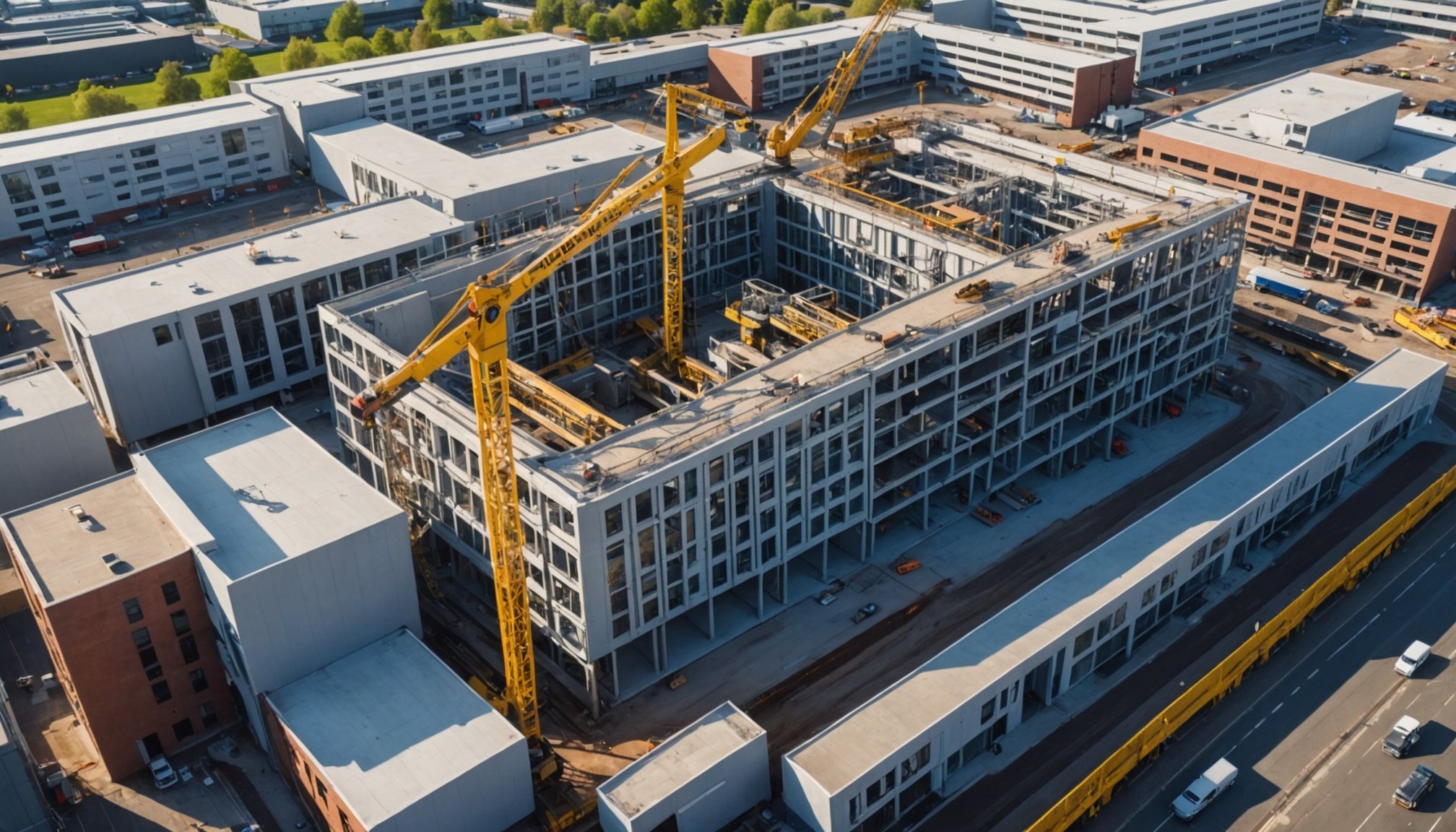Understanding BIM Technology in the UK Construction Industry
Building Information Modeling (BIM Technology) is a key innovation in modern construction, revolutionizing the way projects are planned and executed. In the context of UK construction, BIM involves creating digital representations of a building’s physical and functional characteristics. This method improves collaboration among stakeholders and enhances the overall efficiency of construction projects.
Definition and Importance of BIM in Modern Construction
BIM Technology serves as a critical tool, moving beyond traditional blueprint approaches. It enhances project management by offering a comprehensive outlook on every stage of construction, from design to maintenance. It ensures better resource management, cost effectiveness, and error reduction.
Have you seen this : Unlock government grants: a funding guide for startups in the uk
Overview of Current Utilization in the UK
The UK construction industry is increasingly adopting BIM, driven by government mandates and industry standards aiming for widespread BIM Level 2 implementation. The technology is used across various project scales, offering detailed design models and data integration, which result in significant productivity gains.
Key Benefits of Implementing BIM Technology
Implementing BIM Technology in construction projects delivers numerous benefits:
This might interest you : Unleashing the power of storytelling: a guide for uk businesses to elevate their marketing strategies
- Improved stakeholder communication and decision-making
- Enhanced design accuracy and risk reduction
- Optimized resource utilization and project timelines
The adoption of BIM Technology not only empowers construction teams but also aligns with the UK’s long-term economic and sustainable development goals.
Developing an Effective BIM Implementation Strategy
Creating an effective BIM Implementation Strategy is crucial for successful project management and fostering an efficient workflow. Establishing a BIM roadmap involves several detailed steps, starting with assessing current capabilities and determining the resources required for integration. Defining clear objectives and goals for BIM usage is essential to ensuring that the technology aligns with the overarching aims of the construction project.
Once objectives are established, aligning BIM with project management practices is necessary to streamline processes and facilitate smooth cooperation among team members. This alignment helps in coordinating tasks, enhancing communication, and reducing misunderstandings, ultimately leading to improved project outcomes.
A well-thought-out BIM roadmap encompasses steps such as outlining roles and responsibilities, identifying necessary training for staff, and selecting appropriate technology tools. These elements together form the backbone of an efficient BIM strategy, guiding construction teams through seamless adoption and integration of the technology.
Continuous monitoring and evaluation should be part of the strategy, allowing for adjustments based on project needs and ensuring that BIM technology is applied effectively. This ongoing assessment ensures that project goals are met and that the benefits of BIM implementation are fully realized, leading to optimized project delivery and satisfaction for all stakeholders involved.
Best Practices for Integrating BIM into Projects
Integrating BIM Technology effectively requires careful planning and execution. Establishing collaborative workflows is crucial. Projects must develop a robust communication plan to ensure all stakeholders are on the same page. This fosters collaborative processes, crucial for achieving seamless project delivery.
Establishing Collaborative Workflows
Begin by identifying all team members and their roles in the BIM process. Set up regular meetings to enhance transparency and coordination. Implement data-sharing platforms to facilitate real-time information exchange. Effective collaborative workflows aid in error reduction and improve project timelines.
Training and Development for Team Members
Training is vital for successful BIM integration. Offer comprehensive sessions focusing on both basic and advanced BIM concepts. Encourage team members to seek certifications to deepen their expertise. Continuous professional development ensures teams are equipped to handle evolving project demands efficiently.
Utilizing the Right Software Tools
Choosing the right software is imperative. Evaluate different BIM software tools based on the project’s needs. Ensure they offer compatibility with existing systems and flexibility for future upgrades. Align technology choices with project goals to maximize utility and performance. This strategic selection supports enhanced design accuracy and long-term project success.
Case Studies of Successful BIM Integration in the UK
Examining BIM case studies reveals valuable insights into successful implementations within the UK construction sector. These success stories highlight practical applications and benefits, illuminating paths for future projects.
Notable projects such as Crossrail, a high-speed railway development, have utilized Building Information Modeling to streamline coordination among engineers, architects, and contractors. The system’s efficiency was evident in designing and managing complex underground structures, ensuring all stakeholders had a unified understanding.
The Shard, another iconic UK project, demonstrated how BIM technology can enhance design accuracy and reduce construction risks. Through real-time data integration, the team successfully addressed design challenges, leading to smoother execution and timely completion.
Analysis of outcomes from these projects shows significant efficiency gains. Crossrail experienced reduced conflict rates during construction, translating to cost savings and faster delivery. The Shard benefited from improved design collaboration, which minimized design changes and enhanced structural integrity.
Key lessons learned from these real-world applications focus on early stakeholder engagement and robust training programs. These elements are essential for overcoming adoption barriers and maximizing BIM’s potential in future projects. Encouraging ongoing training and support will sustain the benefits realized and promote continuous improvement within the industry.
Challenges and Solutions in BIM Adoption
Building Information Modeling (BIM) presents challenges in the UK Construction sector. Common obstacles like resistance to change hinder its adoption. Transitioning from traditional methods to BIM requires significant shifts in mindset and processes. Construction teams often face barriers like lack of understanding, insufficient training, and initial cost concerns. Without addressing these, integrating BIM can pose difficulties.
However, strategies exist to overcome these challenges. Education plays a pivotal role. By investing in comprehensive training programs, teams can develop a solid understanding of BIM Technology. This mitigates resistance by enhancing confidence in using digital tools.
Moreover, showcasing success stories can help shift perceptions. Highlighting projects where BIM has delivered measurable benefits encourages acceptance. For instance, sharing examples like reduced errors and enhanced design precision can demonstrate its value.
Risk mitigation is another essential aspect. Establishing a structured BIM Implementation Strategy that includes risk assessment reduces uncertainties. This involves identifying potential pitfalls early and preparing contingencies to tackle them.
Finally, fostering a culture of collaboration aids transition. Encouraging open dialogue among stakeholders fosters a sense of unity. By addressing concerns collectively, construction teams can ensure smoother BIM integration and enhanced project outcomes.
Future Trends of BIM Technology in UK Construction
As BIM Technology continues to evolve, its integration within UK Construction is becoming increasingly profound. Emerging technologies like AI and machine learning are rapidly altering the landscape. These technologies complement Building Information Modeling by enhancing data analysis capabilities, leading to more precise predictions and efficient project management.
Emerging Technologies Complementing BIM
AI innovations streamline processes by automating routine tasks, reducing the probability of human error. By leveraging machine learning, BIM systems can foresee project challenges and recommend solutions, further improving construction outcomes. These advancements underscore the crucial role of technology in maintaining robust project workflows.
The Role of BIM in Sustainable Construction
Environmental concerns push the boundaries of construction innovation. BIM supports sustainable practices by optimizing material usage and reducing waste. By simulating environmental impact during the design phase, BIM aids in constructing eco-friendly infrastructures, aligning with global sustainability goals.
Predictions for BIM’s Impact on the UK Construction Landscape
Long-term, BIM Technology could revolutionize the industry through predictive analytics and enhanced collaboration. The anticipated integration of BIM with virtual and augmented reality will offer immersive experiences, facilitating stakeholder engagement and decision-making. As digital transformation progresses, the UK construction industry is poised to achieve unprecedented levels of efficiency and innovation.











